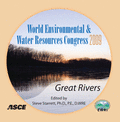Deployable Decentralized Biofilm System to Degrade Organic Carbon, Nutrients and Benzene from Wastewater
Publication: World Environmental and Water Resources Congress 2009: Great Rivers
Abstract
Decentralized wastewater treatment systems are of great importance to protect the environment and people's health in the areas without centralized treatment system. Utilizing laboratory cultivated inoculating microorganisms (suborder Corynebacterineae including Agrobacterium sp. and Gordonia sp.) in logarithmic growth stage, a deployable aqueous aerobic bioreactor (DAAB) system was developed for decentralized wastewater treatment. The system is flexible, deployable in a standard shipping container, quick to start, and capable of removing organic carbon, phosphorus and benzene from wastewater. Experimental results indicated that the inoculated consortium had a faster COD removal rate than sewage-born microorganisms during the startup of the system. During the startup period, the removal of total phosphorus in the aeration tank followed a pseudo first-order kinetics (R2 = 0.90) with a rate constant of 0.027 hr –1. The Agrobacterium sp. are likely responsible for the removal of phosphorus from wastewater. No ammonia removal was found in the aeration tank during the startup phase. After the system was in continuous operation with an average flow rate of 11.4 L/min, the removal efficiency of BOD5 and total suspended solids (TSS) was 83±32% and 84±9%, respectively. The relative large standard deviation of the removal efficiencies is likely due to the small equalization capacity of a small treatment system to resist the variations of the incoming wastewater quality and shock loads. As an important supplement to the pilot studies, laboratorial tests by headspace analysis showed that the Gordonia sp. were able to degrade benzene from wastewater. After 26 hours, more significant biodegradation of benzene was found in sessile form (57±8%) than in planktonic form (25±11%) with minimal glucose. However, no benzene degradation was found in sessile form when no glucose was provided. The result suggested that the Gordonia sp. could not utilize benzene as the sole carbon and energy source.
Get full access to this article
View all available purchase options and get full access to this chapter.
Information & Authors
Information
Published In
Copyright
© 2009 American Society of Civil Engineers.
History
Published online: Apr 26, 2012
ASCE Technical Topics:
- [Inorganic compounds]
- Bacteria
- Benzene
- Biofilm
- Carbon compounds
- Chemical compounds
- Chemical elements
- Chemicals
- Chemistry
- Engineering fundamentals
- Environmental engineering
- Laboratory tests
- Nutrient pollution
- Organic compounds
- Phosphorus
- Pollutants
- Pollution
- Tests (by type)
- Wastewater management
- Wastewater treatment
- Water pollution
- Water treatment
Authors
Metrics & Citations
Metrics
Citations
Download citation
If you have the appropriate software installed, you can download article citation data to the citation manager of your choice. Simply select your manager software from the list below and click Download.
